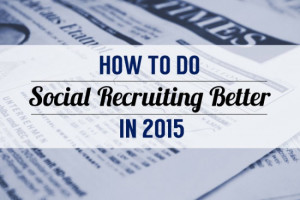By now, many recruiters are familiar with the concept of social recruiting. But just having a Facebook and Twitter presence isn’t enough to really succeed—or stand out. You need to have a strategy that works well for your business need and complements the employer brand. Here are a few ideas to consider when making your 2015 plans to ensure you’ve got all your bases covered.
1) Use your employees and alumni.
Word of mouth continues to be one of the most trusted forms of advertising. If your employees (and alumni) aren’t part of your social strategy, make them a part of it next year. You can start by simply encouraging current employees to like your social recruiting presence. Then target employees with messages around employee referral, content they may want to share, and jobs, with messaging specifically encouraging them to share to their communities. Encourage employees to blog and share their perspectives. Consider integrating alumni into your social strategy through specific alumni groups on LinkedIn or Facebook, regular alumni newsletters, and integrating into the offboarding process. Depending on your company, you may focus on alumni recruiting or simply use them as a way to spread a message. Either way, seeing a job or piece of content endorsed by a current employee or alumni adds credibility and is likely to target candidates who exist outside of those who currently like or follow your social presence.
2) Get niche.
2015 is shaping up to be a year where the web is getting back to its roots. - Click to Tweet
Web 1.0 was about awkward design (remember under construction gifs?) but more importantly, it was also about niche communities that brought together like-minded individuals. This was typified in geocities, webrings, and AOL’s communities and chat rooms. Late 2014 saw the release of Facebook’s Rooms app, and more and more niche social networks devoted to specific topics including the continued popularity of Reddit and Quora. Although it shouldn’t be at the core of your social strategy, look into niche web forums and social networks, especially for hard-to-fill positions. There’s likely a community out there with exactly the people you need. Start by talking to your existing employees to find out what social communities they use, and encourage them to be an active voice for the brand on those platforms.
3) Have a robust content strategy.
It bears repeating that just posting jobs to a social page isn’t a content strategy. Nor is posting 1,000 articles on interviewing tips. Not to say these aren’t valid as part of a content strategy, but they’re not enough to really tell candidates what your brand is about. Enrich your content strategy through content that demonstrates the philosophy with which you create your products. Day in the life content that you generate, statements of belief (“We believe quality should be…”), and highlighting other companies who share a similar belief system (“We love what XXX is doing”), can help candidates identify with what you stand for and make you seem more human by not only talking about you brand. Another part of your content strategy may be to make candidates feel like they’re already part of the company. Tweet about what’s happening in the offices, use Facebook to share videos or articles that are making the rounds at the office, or film employee brainstorming sessions to give a fly-on-the-wall experience. R/GA is a great example of providing content that helps candidates understand what they do, and goes well beyond the typical job and tips experience.
4) Don’t Discount Consumers.
It’s important to understand how and what your candidate is likely to know about you. Too many brands forget that candidates often know you by your products and services first and then investigate further to understand why they might want to work there. If candidates are likely to know you by what you make, be sure your social presence is giving that behind-the-scenes view on how those products come to life. It helps link back to the consumer brand, and can begin to ease transition into your employer brand (i.e. why those products are so good to begin with—the people). More “how we make it” material is not only interesting to candidates, it’s the kind of thing that is more likely to be shared and content your consumer marketing teams may be able to help you create.
5) Email is social, too.
So many social strategies fail to include email. Think of the last time you shared a link or email with a friend by forwarding it on! Unfortunately, many companies don’t include it in their social plan. Bring email into your editorial calendar. Time it to coincide with social programming, and make it something that people will want to forward to their friends. Not only will you have a new channel, but a good email program will be able to track click-through-rates and even forwarding rates so you can get metrics on the effectiveness of your message.
Read More